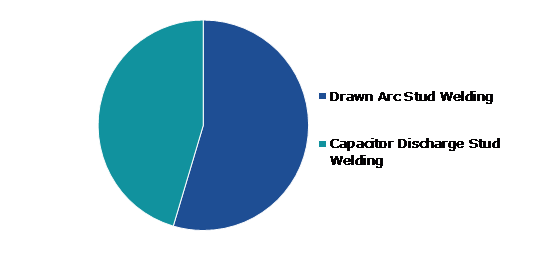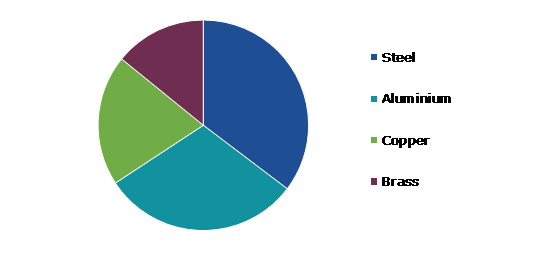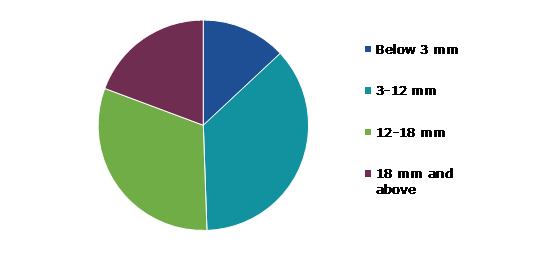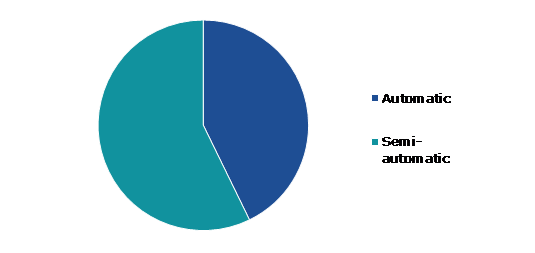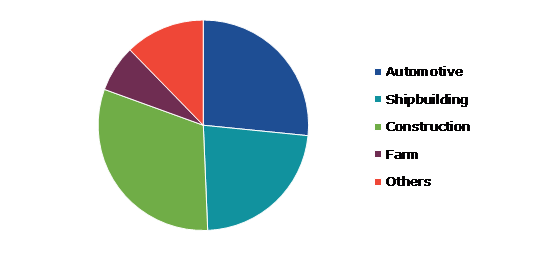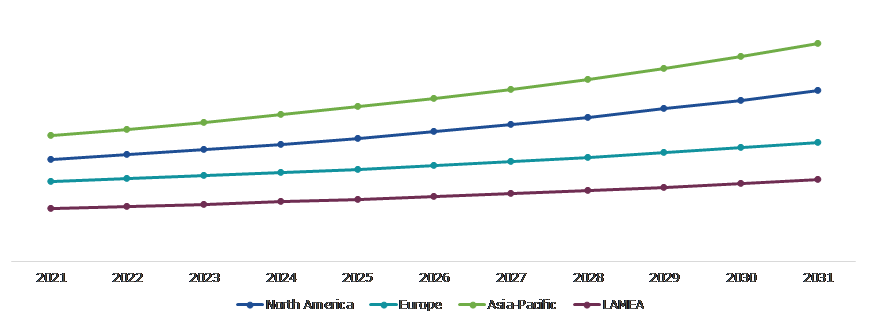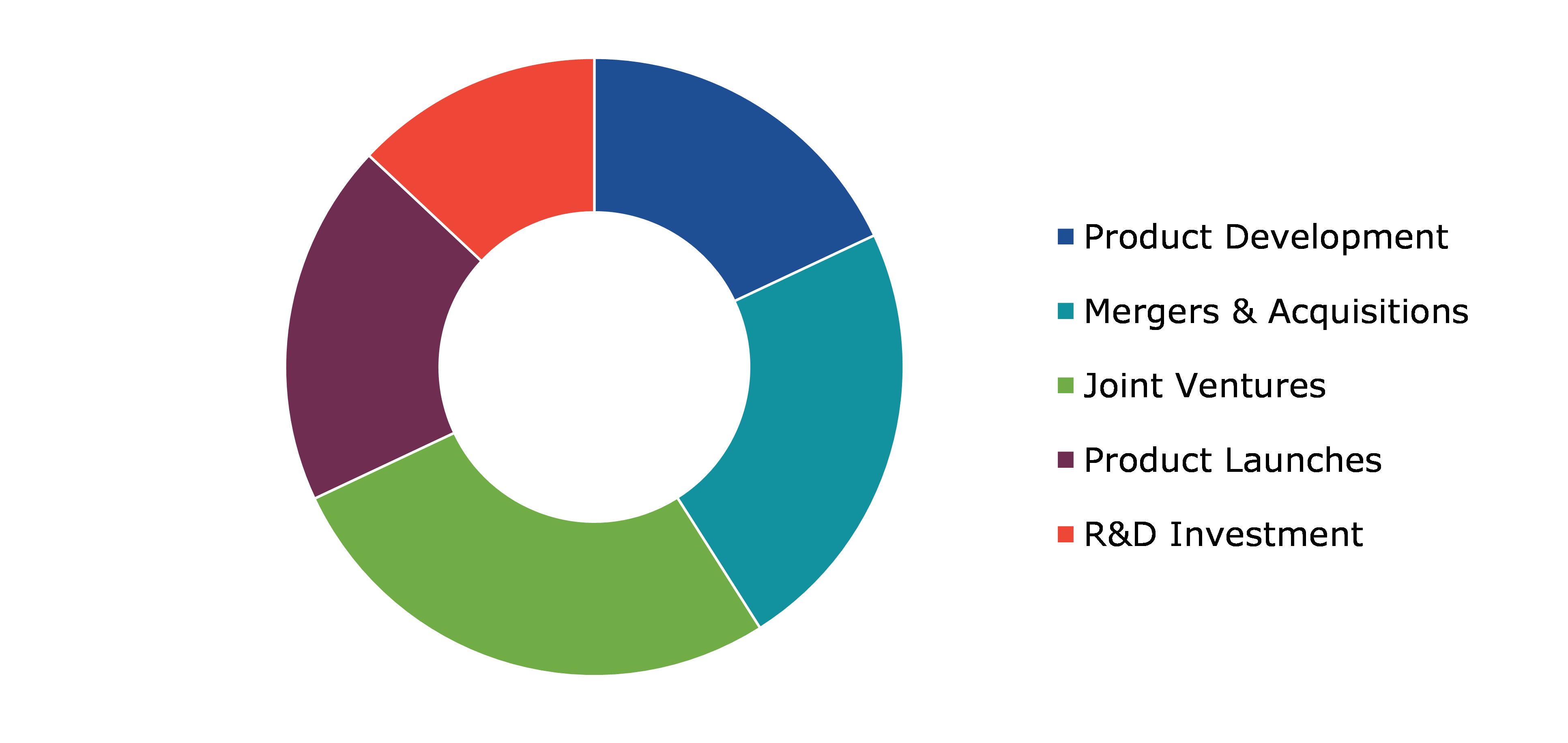Stud Welding Machine Market Report
RA08624
Stud Welding Machine Market by Type of Arc Ignition (Drawn Arc Stud Welding and Capacitor Discharge Stud Welding), Material (Steel, Aluminum, Copper, and Brass), Stud Diameter (Below 3 mm, 3-12 mm, 12-18 mm, and 18 mm and Above), Operation (Automatic and Semi-automatic), End-use Industry (Automotive, Shipbuilding, Electric Goods, Construction, Farm, and Others), and Regional Analysis (North America, Europe, Asia-Pacific, and LAMEA): Global Opportunity Analysis and Industry Forecast, 2022-2031
Global Stud Welding Machine Market Analysis
The Global Stud Welding Machine Market Size was $1,028.8 million in 2021 and is predicted to grow with a CAGR of 5.1%, by generating a revenue of $1,678.8 million by 2031.
Global Stud Welding Machine Market Synopsis
The global stud welding market is anticipated to grow at a notable growth rate during the forecast period owing to the significant expansion of key industry verticals like construction, automotive, and shipbuilding, which are increasingly dependent on the use of stud welding machines in their manufacturing processes. The stud welding machine can be used for welding studs that are made of stainless steel, copper, carbon steel, aluminum, and alloy stud. With the utilization of stud welding machines, welding time is maintained at the millisecond level, so there is minimal thermic effect and welding deformation. The stud welding machine is very suitable for sheet welding thickness greater than 0.5 mm. All these factors are anticipated to drive the market revenue growth during the forecast period.
Numerous building projects and activities, including government infrastructure projects, were completely halted owing to the worldwide lockdowns. The stud welding machine market is highly dependent on end-user industries such as construction and shipbuilding. Hence, instabilities in these sectors are likely to hamper the stud welding machines market growth. Therefore, factors such as a shortage of skilled technical personnel are projected to hamper the market expansion during the forecast period. Some of the limitations associated with stud welding machine is that it can be used to weld small components such as plugs or studs that can easily rotate onto a workpiece at high speed.
The demand for domestic items including cooking stoves, kitchen chimneys, and refrigerators is increasing steadily. The rise in demand for domestic goods is expected to offer lucrative opportunities to the stud welding machine market players as these welding machines are increasingly used in the production of domestic goods such as refrigerators. For instance, in catering and food processing sector, stud welding machines are used for fixing elements to the counters, refrigeration units, and tabletops. Also, the invisible welding that does not cause blackening on the surface of workpiece being weld endures a strong and long-lasting weld to the product. These factors are anticipated to propel the stud welding machine market share during the forecast period.
According to regional analysis, the Asia-Pacific stud welding machine market accounted for the highest market size in 2021. This growth is majorly attributed to the rapid industrialization in various countries in the region, including China, Japan, India, and Indonesia. In addition, expansion in shipbuilding and construction projects is anticipated to further support the regional market growth for stud welding machines in the future.
Stud Welding Machine Overview
Stud welding is an arc welding technique in which metal parts can be end-joined to a workpiece instantaneously. Stud welding applies the same principles and has the same metallurgical characteristics as any other arc welding process. Machines for stud welding are affordable, portable, light, and safe. A computerized monitor on the machine shows crucial data including welding voltage, current, and time.
COVID-19 Impact on Global Stud Welding Machine Market
The COVID-19 pandemic caused strict lockdowns and social isolation across the globe. The pandemic has had a detrimental effect on the market potential for stud welding machines owing to the suspension of manufacturing and production facilities due to a manpower shortage and a delay in the availability of raw materials. Many end-user industries, including the automobile, shipbuilding, and construction witnessed a decline due to import-export restrictions, closed borders, and economic instability. These industries consistently have a significant need for stud welding equipment. Therefore, the decline in these sectors ultimately hindered the expansion of the stud welding machine market during the pandemic. The majority of manufacturing hubs are in the Asia-Pacific region. China and India implemented strict lockdowns and social isolation during the COVID-19 pandemic, which disrupted manufacturing activities for many weeks and caused the country's economy to contract.
Expansion of the Shipbuilding Industry is Expected to Drive the Market Demand for Stud Welding Machines
Shipbuilding activities have expanded because of more goods being transported by sea, which in turn has boosted demand for stud welding equipment. Stud welding machines plays a major role in the shipbuilding industry. For instance, in the shipbuilding sector, the stud welding machines are used for constructing large structures generally made out of steel. Professionals consider welding operations as a crucial one in the shipbuilding sector owing to faster operations and efficient operations facilitated by these machines. The development of welding technology has made it possible to construct completely water- and oil-tight ship constructions. Without the correct use of welding materials and processes, these structures cannot operate effectively or safely. All these are the major factors expected to drive the growth of the stud welding machine market during the forecast period.
To know more about global stud welding machine market drivers, get in touch with our analysts here.
Lack of Skilled Workers is Expected to Hinder the Market Growth
The need for qualified welders is increasing across many industries, including shipbuilding and construction. For instance, a shipyard welder's tasks include a variety of activities such as checking the materials and structures to be welded, building ship components, repairing ship components, and using cutting equipment and torches. For ships and boats to operate securely, shipyard welding must be efficient and effective. However, several industries, like shipbuilding, are struggling to find qualified welders. This, in turn, is anticipated to restrain the stud welding machine market growth in the upcoming years.
Rise in Demand from the Automotive and Construction Sectors is Expected to offer Ample Growth Opportunities During the Forecast Period
The automotive sector majorly uses stud welding machines. This is because when welding fastenings to sheet metal, accuracy and strength is of the utmost importance. Various automotive applications, including heat shields, power steering parts, exhaust systems, insulation, electrical wire routing, and lighting use stud welding machines. In addition, stud welds are also ideal for a variety of construction applications due to their higher strength. Stud welding machines are used in the construction industry for a variety of applications, including building work, and bridge construction. For roads and buildings to be safer, underground systems like sewer pipes and other subsurface services also need to be well-welded. These factors are expected to offer excellent opportunities to stud welding machine market players during the forecast period.
To know more about global stud welding machine market opportunities, get in touch with our analysts here.
Global Stud Welding Machine Market, by Type of Arc Ignition
Based on type of arc ignition, the market has been divided into drawn arc stud welding and capacitor discharge stud welding. Among these, the drawn arc stud welding sub-segment accounted for the highest market share in 2021 and is projected to show the fastest CAGR during the forecast period.
Global Stud Welding Machine Market Size, by Type of Arc Ignition, 2021
Source: Research Dive Analysis
The drawn arc stud welding sub-segment accounted for a dominant market share in 2021 and is projected to show the fastest CAGR during the forecast period. Drawn arc stud welding is a very efficient technique of attaching fasteners mainly to stainless steel and mild steel of 2mm thickness and above by using a steady current DC power supply. This method can tolerate surface curvature and defects like grease, light rust, and scale. This technique employs a welding rectifier that involves an energy source and provides a continuous welding current. Drawn arc stud welding type of arc ignition offers numerous benefits including uniform quality, high duty cycle, and also avoids the need for riveting and drilling.
Global Stud Welding Machine Market, by Material
Based on material, the market has been divided into steel, aluminum, copper, and brass. Among these, the steel sub-segment accounted for the highest revenue share in 2021, whereas the aluminum sub-segment is estimated to show the fastest growth during the forecast period.
Global Stud Welding Machine Market Share, by Material, 2021
Source: Research Dive Analysis
The steel sub-segment accounted for a dominating market share in 2021. Stud welding technique is increasingly used in the shipbuilding industry and steel is the most widely utilized material. High-strength steels are needed for crucial areas of ships. Both stainless steel and mild steel can be stud welded. Generally, steel is a fantastic choice for studs and bases in general because it works well for procedures like drawn arc stud welding and capacitor discharge stud welding.
Global Stud Welding Machine Market, by Stud Diameter
Based on stud diameter, the market has been classified into below 3 mm, 3-12 mm, 12-18 mm, and 18 mm and above. Among these, the 3-12 mm sub-segment accounted for the highest revenue share in 2021.
Global Stud Welding Machine Market Growth, by Stud Diameter, 2021
Source: Research Dive Analysis
The 3-12 mm sub-segment accounted for the largest market share in 2021. The growth of this sub-segment is mainly attributed to its rising application in various sectors including transportation, shipbuilding, marine, and automotive. The usage of 3-12mm studs is known as short cycle stud welding as these studs provide an undisturbed backside finish with a rapid attachment.
Global Stud Welding Machine Market, by Operation
Based on operation, the market has been classified into automatic and semi-automatic. Among these, the semi-automatic sub-segment accounted for the highest revenue share in 2021.
Global Stud Welding Machine Market Forecast, by Operation, 2021
Source: Research Dive Analysis
The semi-automatic sub-segment accounted for the largest market share in 2021. Machines that automatically weld studs are not always the best option. Semi-automatic welding equipment maintains a high level of control while doubling the output of the manual welder. When the quality of the weld is extremely important or when numerous welds need to be done, semi-automatic welding equipment is increasingly being used. These stud welding machines provide many advantages over automated equipment, including higher employee safety, high-quality welding output, reproducibility, high total product output, reduced scrap produced, and others.
Global Stud Welding Machine Market, by End-use Industry
Based on end-use industry, the market has been classified into automotive, shipbuilding, electric goods, construction, farm, and others. Among these, the construction sub-segment accounted for the highest revenue share in 2021.
Global Stud Welding Machine Market Analysis, by End-use Industry, 2021
Source: Research Dive Analysis
The construction sub-segment accounted for the largest market share in 2021. Stud welding is widely used in the construction industry as an alternative to hole punching or spot welding from one surface to another. A variety of applications in the construction sector are suited for the stud welding process because of the increased strength of stud welds. Stud welding is used in the construction sector for a variety of tasks, including building works, bridge construction, and others. Stud welding machines are also used in the construction of an interesting façade. Stud welding is also used for constructing bridges, elevators, staircases, and escalators.
Global Stud Welding Machine Market, Regional Insights
The stud welding machine market was investigated across North America, Europe, Asia-Pacific, and LAMEA.
Global Stud Welding Machine Market Size & Forecast, by Region, 2021-2031 ($ Million)
Source: Research Dive Analysis
The Market for Stud Welding Machine in Asia-Pacific to be the Most Dominant
The Asia-Pacific stud welding machine market accounted for the highest market share in 2021, owing to the rapid industrialization, robust growth in the automotive sector, and increase in heavy engineering and construction projects mainly in countries such as India, China, and Japan. Vehicle sales across the Asia-Pacific region are highest compared to all other regions due to rising population and disposable income. Therefore, the automotive sector in this region is expanding significantly, which ultimately boosts the demand for the stud welding machine market.
Competitive Scenario in the Global Stud Welding Machine Market
Investment, agreement, product launches and developments, and partnerships are some of the common strategies followed by major market players. For instance, in October 2022, STANLEY Engineered Fastening, the manufacturer of stud welding machines declared its plans for an automated production line in the manufacturing of steel with integrated stud welding systems.
Source: Research Dive Analysis
Some of the leading stud welding machine market players are STANLEY Engineered Fastening, Midwest Fasteners Inc., Bolte GmbH, KÖSTER & CO. GMBH, ChangZhou Jinda Welding Co., Ltd., HBS Bolzenschweiss-Systeme GmbH & Co. KG, Taylor Studwelding Systems Ltd, HEINZ SOYER BOLZENSCHWEISSTECHNIK GMBH, Cruxweld Industrial Equipments Private Limited, and TFP Corporation.
| Aspect | Particulars |
| Historical Market Estimations | 2020 |
| Base Year for Market Estimation | 2021 |
| Forecast Timeline for Market Projection | 2022-2031 |
| Geographical Scope | North America, Europe, Asia-Pacific, and LAMEA |
| Segmentation by Type of Arc Ignition |
|
| Segmentation by Material |
|
| Segmentation by Stud Diameter |
|
| Segmentation by Operation |
|
| Segmentation by End-use Industry |
|
| Key Companies Profiled |
|
Q1. What is the size of the global stud welding machine market?
A. The size of the global stud welding machine market was over $1,028.8 million in 2021 and is projected to reach $1,678.8 million by 2031.
Q2. Which are the major companies in the stud welding machine market?
A. Midwest Fasteners Inc., KÖSTER & CO. GMBH, and Bolte GmbH are some of the key players in the global stud welding machine market.
Q3. Which region, among others, possesses greater investment opportunities in the future?
A. Asia-Pacific possesses great investment opportunities for investors in the future.
Q4. What will be the growth rate of the Asia-Pacific stud welding machine market?
A. Asia-Pacific stud welding machine market is anticipated to grow at 5.7% CAGR during the forecast period.
Q5. What are the strategies opted by the leading players in this market?
A. Agreement and investment are the two key strategies opted by the operating companies in this market.
Q6. Which companies are investing more on R&D practices?
A. Taylor Studwelding Systems Ltd, HBS Bolzenschweiss-Systeme GmbH & Co. KG, and Bolte GmbH are the companies investing more on R&D activities for developing new products and technologies.
1.Research Methodology
1.1.Desk Research
1.2.Real time insights and validation
1.3.Forecast model
1.4.Assumptions and forecast parameters
1.5.Market size estimation
1.5.1.Top-down approach
1.5.2.Bottom-up approach
2.Report Scope
2.1.Market definition
2.2.Key objectives of the study
2.3.Report overview
2.4.Market segmentation
2.5.Overview of the impact of COVID-19 on Global stud welding machine market
3.Executive Summary
4.Market Overview
4.1.Introduction
4.2.Growth impact forces
4.2.1.Drivers
4.2.2.Restraints
4.2.3.Opportunities
4.3.Market value chain analysis
4.3.1.List of raw material suppliers
4.3.2.List of manufacturers
4.3.3.List of distributors
4.4.Innovation & sustainability matrices
4.4.1.Technology matrix
4.4.2.Regulatory matrix
4.5.Porter’s five forces analysis
4.5.1.Bargaining power of suppliers
4.5.2.Bargaining power of consumers
4.5.3.Threat of substitutes
4.5.4.Threat of new entrants
4.5.5.Competitive rivalry intensity
4.6.PESTLE analysis
4.6.1.Political
4.6.2.Economical
4.6.3.Social
4.6.4.Technological
4.6.5.Environmental
4.7.Impact of COVID-19 on Stud Welding Machine market
4.7.1.Pre-covid market scenario
4.7.2.Post-covid market scenario
5.Stud Welding Machine Market Analysis, by Type of Arc Ignition
5.1.Overview
5.2.Drawn Arc Stud Welding
5.2.1.Definition, key trends, growth factors, and opportunities
5.2.2.Market size analysis, by region,2022-2031
5.2.3.Market share analysis, by country,2022-2031
5.3.Capacitor Discharge Stud Welding
5.3.1.Definition, key trends, growth factors, and opportunities
5.3.2.Market size analysis, by region,2022-2031
5.3.3.Market share analysis, by country,2022-2031
5.4.Research Dive Exclusive Insights
5.4.1.Market attractiveness
5.4.2.Competition heatmap
6.Stud Welding Machine Market, by Material
6.1.Steel
6.1.1.Definition, key trends, growth factors, and opportunities
6.1.2.Market size analysis, by region,2022-2031
6.1.3.Market share analysis, by country,2022-2031
6.2.Aluminum
6.2.1.Definition, key trends, growth factors, and opportunities
6.2.2.Market size analysis, by region,2022-2031
6.2.3.Market share analysis, by country,2022-2031
6.3.Copper
6.3.1.Definition, key trends, growth factors, and opportunities
6.3.2.Market size analysis, by region,2022-2031
6.3.3.Market share analysis, by country,2022-2031
6.4.Brass
6.4.1.Definition, key trends, growth factors, and opportunities
6.4.2.Market size analysis, by region,2022-2031
6.4.3.Market share analysis, by country,2022-2031
6.5.Research Dive Exclusive Insights
6.5.1.Market attractiveness
6.5.2.Competition heatmap
7.Stud Welding Machine Market, by Stud Diameter
7.1.Below 3 mm
7.1.1.Definition, key trends, growth factors, and opportunities
7.1.2.Market size analysis, by region,2022-2031
7.1.3.Market share analysis, by country,2022-2031
7.2.3-12 mm
7.2.1.Definition, key trends, growth factors, and opportunities
7.2.2.Market size analysis, by region,2022-2031
7.2.3.Market share analysis, by country,2022-2031
7.3.12-18 mm
7.3.1.Definition, key trends, growth factors, and opportunities
7.3.2.Market size analysis, by region,2022-2031
7.3.3.Market share analysis, by country,2022-2031
7.4.18 mm and Above
7.4.1.Definition, key trends, growth factors, and opportunities
7.4.2.Market size analysis, by region,2022-2031
7.4.3.Market share analysis, by country,2022-2031
7.5.Research Dive Exclusive Insights
7.5.1.Market attractiveness
7.5.2.Competition heatmap
8.Stud Welding Machine Market, by Operation
8.1.Automatic
8.1.1.Definition, key trends, growth factors, and opportunities
8.1.2.Market size analysis, by region,2022-2031
8.1.3.Market share analysis, by country,2022-2031
8.2.Semi-automatic
8.2.1.Definition, key trends, growth factors, and opportunities
8.2.2.Market size analysis, by region,2022-2031
8.2.3.Market share analysis, by country,2022-2031
8.3.Research Dive Exclusive Insights
8.3.1.Market attractiveness
8.3.2.Competition heatmap
9.Stud Welding Machine Market, by End-use Industry
9.1.Automotive
9.1.1.Definition, key trends, growth factors, and opportunities
9.1.2.Market size analysis, by region,2022-2031
9.1.3.Market share analysis, by country,2022-2031
9.2.Shipbuilding
9.2.1.Definition, key trends, growth factors, and opportunities
9.2.2.Market size analysis, by region,2022-2031
9.2.3.Market share analysis, by country,2022-2031
9.3.Electric Goods
9.3.1.Definition, key trends, growth factors, and opportunities
9.3.2.Market size analysis, by region,2022-2031
9.3.3.Market share analysis, by country,2022-2031
9.4.Construction
9.4.1.Definition, key trends, growth factors, and opportunities
9.4.2.Market size analysis, by region,2022-2031
9.4.3.Market share analysis, by country,2022-2031
9.5.Farm
9.5.1.Definition, key trends, growth factors, and opportunities
9.5.2.Market size analysis, by region,2022-2031
9.5.3.Market share analysis, by country,2022-2031
9.6.Others
9.6.1.Definition, key trends, growth factors, and opportunities
9.6.2.Market size analysis, by region,2022-2031
9.6.3.Market share analysis, by country,2022-2031
9.7.Research Dive Exclusive Insights
9.7.1.Market attractiveness
9.7.2.Competition heatmap
10.Stud Welding Machine Market, by Region
10.1.North America
10.1.1.U.S.
10.1.1.1.Market size analysis, by Type of Arc Ignition,2022-2031
10.1.1.2.Market size analysis, by Material,2022-2031
10.1.1.3.Market size analysis, by Stud Diameter,2022-2031
10.1.1.4.Market size analysis, by Operation,2022-2031
10.1.1.5.Market size analysis, by End-use Industry,2022-2031
10.1.2.Canada
10.1.2.1.Market size analysis, by Type of Arc Ignition,2022-2031
10.1.2.2.Market size analysis, by Material,2022-2031
10.1.2.3.Market size analysis, by Stud Diameter,2022-2031
10.1.2.4.Market size analysis, by Operation,2022-2031
10.1.2.5.Market size analysis, by End-use Industry,2022-2031
10.1.3.Mexico
10.1.3.1.Market size analysis, by Type of Arc Ignition,2022-2031
10.1.3.2.Market size analysis, by Material,2022-2031
10.1.3.3.Market size analysis, by Stud Diameter,2022-2031
10.1.3.4.Market size analysis, by Operation,2022-2031
10.1.3.5.Market size analysis, by End-use Industry,2022-2031
10.1.4.Research Dive Exclusive Insights
10.1.4.1.Market attractiveness
10.1.4.2.Competition heatmap
10.2.Europe
10.2.1.Germany
10.2.1.1.Market size analysis, by Type of Arc Ignition,2022-2031
10.2.1.2.Market size analysis, by Material,2022-2031
10.2.1.3.Market size analysis, by Stud Diameter,2022-2031
10.2.1.4.Market size analysis, by Operation,2022-2031
10.2.1.5.Market size analysis, by End-use Industry,2022-2031
10.2.2.U.K.
10.2.2.1.Market size analysis, by Type of Arc Ignition,2022-2031
10.2.2.2.Market size analysis, by Material,2022-2031
10.2.2.3.Market size analysis, by Stud Diameter,2022-2031
10.2.2.4.Market size analysis, by Operation,2022-2031
10.2.2.5.Market size analysis, by End-use Industry,2022-2031
10.2.3.France
10.2.3.1.Market size analysis, by Type of Arc Ignition,2022-2031
10.2.3.2.Market size analysis, by Material,2022-2031
10.2.3.3.Market size analysis, by Stud Diameter,2022-2031
10.2.3.4.Market size analysis, by Operation,2022-2031
10.2.3.5.Market size analysis, by End-use Industry,2022-2031
10.2.4.Spain
10.2.4.1.Market size analysis, by Type of Arc Ignition,2022-2031
10.2.4.2.Market size analysis, by Material,2022-2031
10.2.4.3.Market size analysis, by Stud Diameter,2022-2031
10.2.4.4.Market size analysis, by Operation,2022-2031
10.2.4.5.Market size analysis, by End-use Industry,2022-2031
10.2.5.Italy
10.2.5.1.Market size analysis, by Type of Arc Ignition,2022-2031
10.2.5.2.Market size analysis, by Material,2022-2031
10.2.5.3.Market size analysis, by Stud Diameter,2022-2031
10.2.5.4.Market size analysis, by Operation,2022-2031
10.2.5.5.Market size analysis, by End-use Industry,2022-2031
10.2.6.Rest of Europe
10.2.6.1.Market size analysis, by Type of Arc Ignition,2022-2031
10.2.6.2.Market size analysis, by Material,2022-2031
10.2.6.3.Market size analysis, by Stud Diameter,2022-2031
10.2.6.4.Market size analysis, by Operation,2022-2031
10.2.6.5.Market size analysis, by End-use Industry,2022-2031
10.2.7.Research Dive Exclusive Insights
10.2.7.1.Market attractiveness
10.2.7.2.Competition heatmap
10.3.Asia-Pacific
10.3.1.China
10.3.1.1.Market size analysis, by Type of Arc Ignition,2022-2031
10.3.1.2.Market size analysis, by Material,2022-2031
10.3.1.3.Market size analysis, by Stud Diameter,2022-2031
10.3.1.4.Market size analysis, by Operation,2022-2031
10.3.1.5.Market size analysis, by End-use Industry,2022-2031
10.3.2.Japan
10.3.2.1.Market size analysis, by Type of Arc Ignition,2022-2031
10.3.2.2.Market size analysis, by Material,2022-2031
10.3.2.3.Market size analysis, by Stud Diameter,2022-2031
10.3.2.4.Market size analysis, by Operation,2022-2031
10.3.2.5.Market size analysis, by End-use Industry,2022-2031
10.3.3.India
10.3.3.1.Market size analysis, by Type of Arc Ignition,2022-2031
10.3.3.2.Market size analysis, by Material,2022-2031
10.3.3.3.Market size analysis, by Stud Diameter,2022-2031
10.3.3.4.Market size analysis, by Operation,2022-2031
10.3.3.5.Market size analysis, by End-use Industry,2022-2031
10.3.4.Australia
10.3.4.1.Market size analysis, by Type of Arc Ignition,2022-2031
10.3.4.2.Market size analysis, by Material,2022-2031
10.3.4.3.Market size analysis, by Stud Diameter,2022-2031
10.3.4.4.Market size analysis, by Operation,2022-2031
10.3.4.5.Market size analysis, by End-use Industry,2022-2031
10.3.5.South Korea
10.3.5.1.Market size analysis, by Type of Arc Ignition,2022-2031
10.3.5.2.Market size analysis, by Material,2022-2031
10.3.5.3.Market size analysis, by Stud Diameter,2022-2031
10.3.5.4.Market size analysis, by Operation,2022-2031
10.3.5.5.Market size analysis, by End-use Industry,2022-2031
10.3.6.Rest of Asia Pacific
10.3.6.1.Market size analysis, by Type of Arc Ignition,2022-2031
10.3.6.2.Market size analysis, by Material,2022-2031
10.3.6.3.Market size analysis, by Stud Diameter,2022-2031
10.3.6.4.Market size analysis, by Operation,2022-2031
10.3.6.5.Market size analysis, by End-use Industry,2022-2031
10.3.7.Research Dive Exclusive Insights
10.3.7.1.Market attractiveness
10.3.7.2.Competition heatmap
10.4.LAMEA
10.4.1.Brazil
10.4.1.1.Market size analysis, by Type of Arc Ignition,2022-2031
10.4.1.2.Market size analysis, by Material,2022-2031
10.4.1.3.Market size analysis, by Stud Diameter,2022-2031
10.4.1.4.Market size analysis, by Operation,2022-2031
10.4.1.5.Market size analysis, by End-use Industry,2022-2031
10.4.2.Saudi Arabia
10.4.2.1.Market size analysis, by Type of Arc Ignition,2022-2031
10.4.2.2.Market size analysis, by Material,2022-2031
10.4.2.3.Market size analysis, by Stud Diameter,2022-2031
10.4.2.4.Market size analysis, by Operation,2022-2031
10.4.2.5.Market size analysis, by End-use Industry,2022-2031
10.4.3.UAE
10.4.3.1.Market size analysis, by Type of Arc Ignition,2022-2031
10.4.3.2.Market size analysis, by Material,2022-2031
10.4.3.3.Market size analysis, by Stud Diameter,2022-2031
10.4.3.4.Market size analysis, by Operation,2022-2031
10.4.3.5.Market size analysis, by End-use Industry,2022-2031
10.4.4.South Africa
10.4.4.1.Market size analysis, by Type of Arc Ignition,2022-2031
10.4.4.2.Market size analysis, by Material,2022-2031
10.4.4.3.Market size analysis, by Stud Diameter,2022-2031
10.4.4.4.Market size analysis, by Operation,2022-2031
10.4.4.5.Market size analysis, by End-use Industry,2022-2031
10.4.5.Rest of LAMEA
10.4.5.1.Market size analysis, by Type of Arc Ignition,2022-2031
10.4.5.2.Market size analysis, by Material,2022-2031
10.4.5.3.Market size analysis, by Stud Diameter,2022-2031
10.4.5.4.Market size analysis, by Operation,2022-2031
10.4.5.5.Market size analysis, by End-use Industry,2022-2031
10.4.6.Research Dive Exclusive Insights
10.4.6.1.Market attractiveness
10.4.6.2.Competition heatmap
11.Competitive Landscape
11.1.Top winning strategies, 2022
11.1.1.By strategy
11.1.2.By year
11.2.Strategic overview
11.3.Market share analysis, 2021
12.Company Profiles
12.1.STANLEY Engineered Fastening
12.1.1.Overview
12.1.2.Business segments
12.1.3.Product portfolio
12.1.4.Financial performance
12.1.5.Recent developments
12.1.6.SWOT analysis
12.2.Midwest Fasteners Inc.
12.2.1.Overview
12.2.2.Business segments
12.2.3.Product portfolio
12.2.4.Financial performance
12.2.5.Recent developments
12.2.6.SWOT analysis
12.3.Bolte GmbH
12.3.1.Overview
12.3.2.Business segments
12.3.3.Product portfolio
12.3.4.Financial performance
12.3.5.Recent developments
12.3.6.SWOT analysis
12.4.KÖSTER & CO. GMBH
12.4.1.Overview
12.4.2.Business segments
12.4.3.Product portfolio
12.4.4.Financial performance
12.4.5.Recent developments
12.4.6.SWOT analysis
12.5.ChangZhou Jinda Welding Co., Ltd.
12.5.1.Overview
12.5.2.Business segments
12.5.3.Product portfolio
12.5.4.Financial performance
12.5.5.Recent developments
12.5.6.SWOT analysis
12.6.HBS Bolzenschweiss-Systeme GmbH & Co. KG
12.6.1.Overview
12.6.2.Business segments
12.6.3.Product portfolio
12.6.4.Financial performance
12.6.5.Recent developments
12.6.6.SWOT analysis
12.7.Taylor Studwelding Systems Ltd
12.7.1.Overview
12.7.2.Business segments
12.7.3.Product portfolio
12.7.4.Financial performance
12.7.5.Recent developments
12.7.6.SWOT analysis
12.8.HEINZ SOYER BOLZENSCHWEISSTECHNIK GMBH
12.8.1.Overview
12.8.2.Business segments
12.8.3.Product portfolio
12.8.4.Financial performance
12.8.5.Recent developments
12.8.6.SWOT analysis
12.9.Cruxweld Industrial Equipments Private Limited
12.9.1.Overview
12.9.2.Business segments
12.9.3.Product portfolio
12.9.4.Financial performance
12.9.5.Recent developments
12.9.6.SWOT analysis
12.10.TFP Corporation
12.10.1.Overview
12.10.2.Business segments
12.10.3.Product portfolio
12.10.4.Financial performance
12.10.5.Recent developments
12.10.6.SWOT analysis
A stud welding machine is a tool that is used to perform the stud welding process. This process includes the joining of two metal components together by heating a metal stud and fusing it to the base metal. The stud welding process is used in a wide range of industries, including construction, automotive, and furniture production. The stud machine consists of a power supply, a welding gun, and a control system. The welding gun is used to place a stud onto a workpiece, and the power supply generates an electric arc to fuse the stud and the workpiece. Stud welding techniques impart various advantages such as providing strong and durable joints, acting as a quicker and more efficient method, delivering a clean and aesthetic look to different types of furniture, reducing waste of material, and many others.
Forecast Analysis of the Global Stud Welding Machine Market
According to the report published by Research Dive, the global stud welding machine market is anticipated to generate $1,678.8 million in revenue and grow at a healthy CAGR of 5.1% over the forecast timeframe 2022-2031.
The increasing expansion of shipbuilding activities due to the increase in the transportation of goods by sea is expected to augment the growth of the stud welding machine market during the forecast timeframe. Moreover, the growing need for faster and more efficient operations in the shipbuilding sector is further expected to boost the growth of the market over the analysis period. Moreover, the rising demand for stud welding machines from the automotive and construction sectors for better accuracy and strength is predicted to create immense growth opportunities for the market throughout the estimated period. However, the lack of skilled workers may hamper the growth of the market over the analysis timeframe.
The major players of the stud welding machine market include HBS Bolzenschweiss-Systeme GmbH & Co. KG, Changzhou Jinda Welding Co., Ltd., Taylor Studwelding Systems Ltd., KÖSTER & CO. GMBH, HEINZ SOYER BOLZENSCHWEISSTECHNIK GMBH, Bolte GmbH, Cruxweld Industrial Equipments Private Limited, Midwest Fasteners Inc., TFP Corporation, STANLEY Engineered Fastening, and many more.
Key Market Developments
The key companies operating in the industry are adopting various growth strategies & business tactics such as partnerships, collaborations, mergers & acquisitions, and launches to maintain a robust position in the overall market, which is subsequently helping the global stud welding machine market to grow exponentially. For instance:
- In July 2021, HBS Bolzenschweiss-Systeme, a leading provider of innovative solutions in welding technology, launched its new product namely, Visar 1200. This product is designed to weld stainless steel and aluminum with high-quality welding results and exact reproducibility due to the implementation of controlled algorithm processes.
- In September 2021, IVOSTUD GmbH, a leading provider of automated stud welding systems, announced its acquisition of OBTEC, a leading manufacturer of high-quality fastening elements for both industrial and automotive end markets. With this acquisition, IVOSTUD GmbH aimed to expand its production capacity and strengthen its position in the stud welding technology sector.
- In December 2022, STANLEY Engineered Fastening, a renowned manufacturer of stud welding machines announced its plans to support the manufacturing of commercial electric vehicles with integrated stud welding systems, compressors, and high-pressure hydraulic pumps.
Most Productive Region
The Asia-Pacific region of the stud welding machine market generated the highest revenue in 2021 and is expected to continue steady growth over the estimated period. Rapid industrialization, the growing automotive sector, and the rise in heavy engineering and construction projects are the major factors expected to drive the regional growth of the market in the coming period. Additionally, the rising population and disposable income among individuals in this region are expected to enhance the growth of the market over the analysis period.
Covid-19 Impact on the Global Stud Welding Machine Market
The rise of the Covid-19 pandemic has had a disastrous impact on the stud welding machine market, likewise, various other industries. This is mainly due to the strict lockdowns, social isolation, closure of manufacturing and production facility due to the shortage of manpower and delay in the availability of raw materials during the pandemic. Moreover, the reduced demand for stud welding machines from various end-use industries such as shipbuilding, automobile, and many others due to import-export restrictions, economic instability, and sealed borders has declined the market growth over the crisis.
Personalize this research
- Triangulate with your own data
- Request your format and definition
- Get a deeper dive on a specific application, geography, customer or competitor
- + 1-888-961-4454 Toll - Free
- support@researchdive.com


